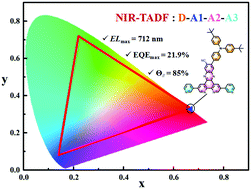An extended π-backbone for highly efficient near-infrared thermally activated delayed fluorescence with enhanced horizontal molecular orientation†
Abstract
Near-infrared thermally activated delayed fluorescence (NIR-TADF) materials with emission over 700 nm have been insufficiently investigated mainly due to the limited choice of strong donor/acceptor units for molecular construction and the limited electronic coupling between the donors and acceptors. Herein, a novel D–A1–A2–A3 configuration was developed for the design of a NIR-TADF material (TPA-CN-N4-2PY), in which three types of sub-acceptor units (CN: cyano; N4: dipyrido[3,2-a:2′,3′-c]phenazine; PY: pyridine) were incorporated into a molecular skeleton to reinforce the electron-accepting strength. The attachment of two pyridine units on TPA-CN-N4 produced TPA-CN-N4-2PY with an extended π-backbone, which shifted the electroluminescence (EL) emission into the NIR region and enhanced the horizontal ratio of emitting dipole orientation (Θ//) simultaneously. TPA-CN-N4-2PY-based OLEDs demonstrated a record-high external quantum efficiency (EQE) of 21.9% with an emission peak at 712 nm and Θ// = 85% at the doping ratio of 9.0 wt%. On the contrary, the parent compound TPA-CN-N4-based OLEDs at the same doping ratio achieved an EQE of 23.4% at 678 nm with Θ// = 75%. This multiple sub-acceptors approach could enrich the design strategy of the NIR-TADF materials, and the large conjugated system could improve the Θ// for achieving efficient emitters.



 Please wait while we load your content...
Please wait while we load your content...